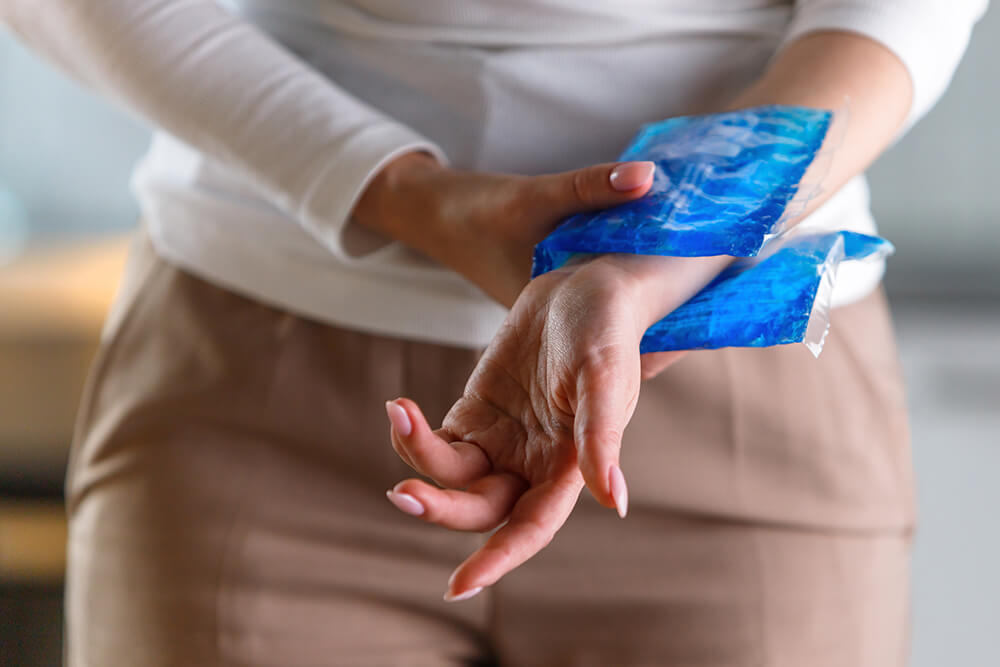After surgery, you will need help managing the pain and may eventually be asked to go to physical therapy to regain your strength and mobility. Cold therapy is a time-tested recovery technique that physical therapists and other medical specialists often use. Read on to learn more about cold therapy and how long you should use it after surgery.
What is cold therapy?
Cold therapy is part of the RICE (rest, ice, compression and elevation) treatment protocol. Cold therapy is designed to alleviate pain and reduce swelling by restricting blood flow to a particular area of the body.
There are many ways to apply cold therapy to your body after surgery. You can use an ice or gel pack held in place with an elastic bandage. Coolant sprays, cold compresses or specialized cold therapy machines may also be used. A cold therapy machine circulates water through an ice reservoir and is more effective than ice therapy alone. It keeps the temperature more consistent and is portable.
Why is cold therapy used after surgery?
Your surgeon or physical therapist may recommend using cold therapy after your surgery for several reasons, including:
- Helping control swelling while the incision and operated tissue heal.
- Helping ease pain with less or no pain medication.
- Decreasing pain by numbing nerve endings, slowing down communication between your body and your brain, which results in less pain.
How long should you apply cold therapy to your body?
Cold therapy is a very useful recovery technique for after your surgery. However, it should only be applied for short periods of time due to the rapid decrease of skin temperatures it can cause. In addition, prolonged direct skin contact can lead to significant reductions in blood flow, possibly leading to tissue death or nerve damage. Exposing the area to cold for too long also limits the flow of nutrients that boost healing. To avoid these issues, cold therapy should be used for 10 to 20 minutes followed by a rest period where the cold therapy device is removed.
What to avoid when using cold therapy after surgery
There are several things that you’ll want to avoid as you’re using cold therapy during your recovery. These things include:
- Don’t fall asleep during a cold therapy session — It is vital that you are awake and alert when using cold therapy to avoid complications due to too much exposure to cold.
- Pay attention to your body’s reaction to cold therapy — Your body can tell you how long to use cold therapy. If you experience excessive redness, your body is telling you you are using cold therapy for too long. Redness indicates it is time to remove and shorten the time period of use.
- Avoid direct skin contact — You’ll want to avoid direct skin contact with the ice pack or other cold therapy device. Otherwise, your cold therapy sessions will have to be shorter to avoid complications. Avoiding direct skin contact with the cold source can be accomplished by wrapping it in a dish or hand towel.
- Avoid excessive use of cold therapy — Do not use cold therapy longer than recommended by your doctor or physical therapist. Too much inflammation reduction delays the healing process. Some inflammation is essential to your recovery.
Why you should add physical therapy to your surgery recovery
After you have surgery, you are likely experiencing pain and possibly having difficulty moving. Muscle stiffness and weakness are typical after surgery. Most of the time, the pain and stiffness are temporary, but working with a physical therapist during postoperative recovery can be very beneficial.
A physical therapist can answer any questions you may have about your rehabilitation and use of cold therapy. They can also work with your doctor to create a safe plan for your rehab that’s based on your symptoms, surgery type and medical history. They can also recommend at-home treatments to you and help you learn how to use them to optimize your daily routine for recovery.
Physical therapists use a variety of techniques to help with surgery recovery. Hands-on techniques, also called manual therapy, can be used to help improve the mobility of joints or soft tissue. Aquatic therapy in a heated pool may also be used. It can allow a patient to tolerate more exercises post-surgery such as strengthening and light aerobic exercises.
Explore how Peak Performance physical therapists can help
At Peak Performance, our physical therapists are expertly trained to assist their patients. Doctors prescribe physical therapy to ensure that your body heals properly. Our goal is to have you on the road to recovery as soon as possible. Our specialists can start by performing a free screening for you; this allows them to formulate a personalized physical therapy plan for you.
Contact us today for more information about how we can assist you after surgery or to schedule an initial appointment.
